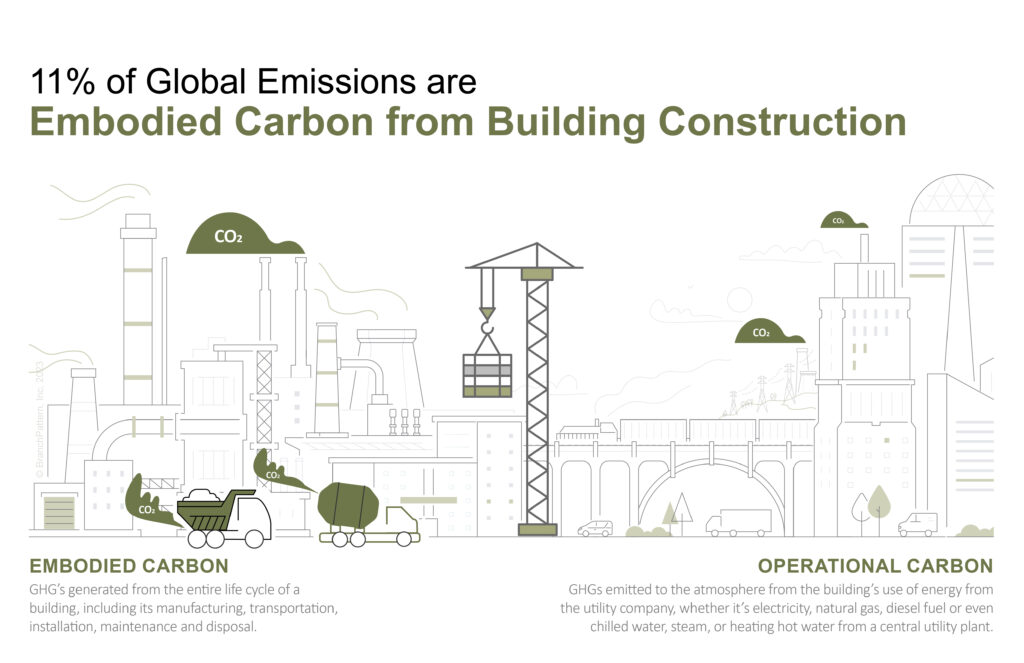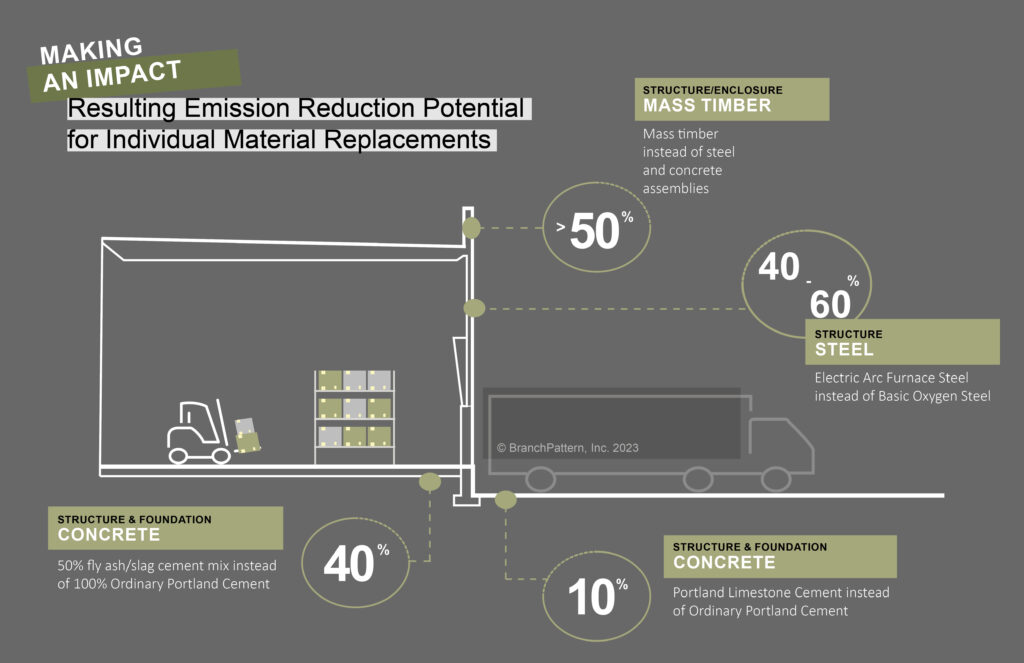Every industry is being challenged to reduce greenhouse gas emissions, especially with the U.S. government’s commitment to combat climate change and increase funding for these efforts. The construction industry has a considerable impact on global greenhouse gas emissions primarily due to its significant contributions to operational and embodied carbon, accounting for 28% and 11%, respectively, of total emissions.
To examine the impact of industrial real estate emissions and reduction strategies, BranchPattern, a national sustainability and engineering firm, recently released its 2023 Benchmark Study on Embodied Carbon in U.S. Industrial Real Estate in partnership with five major industrial real estate developers: Affinius Capital, Bridge Industrial, Brookfield Properties, IDI Logistics, and Prologis. Representatives from these companies are speaking at NAIOP’s upcoming CRE.Converge conference on Oct. 19 about the study’s findings and broader implications of materials selection as an effort to combat climate change. The panel will examine how the real estate industry defines carbon emissions, the typical contributors, and ways to reduce embodied carbon emissions. Read on to learn more about this important topic and why it’s coming to the forefront for building owners and developers.
Why are companies measuring carbon emissions?
“Carbon” is a common term used for greenhouse gas emissions (GHGs); however, “carbon dioxide equivalent (CO2e)” is the metric used to measure the total Global Warming Potential, which factors in the impact of all greenhouse gas emissions. GHGs include a range of compounds, including, but not limited to, carbon dioxide (CO2), methane, fluorinated gases and nitrous oxide. Investors are inquiring about the overall environmental impact of their developments, and a critical strategy for mitigating climate change for investment firms is to reduce carbon emissions associated with projects.

How is embodied carbon measured?
The commercial real estate industry is beginning to adopt Whole Building Life Cycle Assessments (WBLCA), a method used to quantify GHG emissions associated with building materials and evaluate reduction strategies. Greater access to embodied carbon measurement tools and comparative data helps the industry make more informed decisions on materials’ environmental impacts when designing and constructing commercial buildings. In the recently published benchmark study, BranchPattern conducted a meta-analysis of 26 WBLCAs, projects constructed by nine separate developers in six regions within the U.S.
Why should developers care about embodied carbon emissions?
While the electric grid is being sourced more from renewable resources, and ultimately tenants have control over the operations of the building, developers see embodied carbon as a real opportunity to make an impact. Companies are receiving pressure to publish environmental, social and governance (ESG) reports documenting emissions reductions and commit to reduction goals, such as science-based targets. With developers having direct control over embodied carbon emissions (those associated with building materials) and less control over operational carbon emissions (those associated with operating the building), embodied carbon is coming into the forefront as a major opportunity for developers to make decisions, potentially resulting in a greater impact.
How can embodied carbon be reduced?
High-carbon materials are ubiquitous in the built environment, and lower-impact substitutions are increasingly evaluated. Concrete, other cement-based materials and steel are all major contributors to GHG emissions. While embodied carbon in buildings account for at least 11% of global GHG emissions annually, concrete and steel alone account for 11% and 10% of global GHG emissions annually (respectively) due to the ubiquitous use of these materials in other sectors beyond the building sector. As such, chiefly addressing concrete and steel emissions is critical to the global effort to reduce construction impact on climate change. Some of the most common replacement materials, their reduction potential, and their limitations are presented below, with more details available in the study.

What are developers currently doing to reduce embodied carbon emissions?
The first step toward mitigating the environmental impact of each project is to measure current projects. This not only allows companies to promptly relay average emissions data to potential investors for upcoming projects, but also establishes a baseline for enhancing design guidelines and requirements. Companies are establishing protocols for carbon accounting programs, which comprehensively quantify all greenhouse gas emissions linked to a project. Once a baseline is established, it’s time to reduce emissions. This can be achieved by evaluating design guidelines and specifications to make decisions based on the largest impact for carbon reduction. During the panel discussion at CRE.Converge, speakers will delve into their material selections for pilot projects and portfolio-wide requirements, detailing the resulting emissions reduction they achieved.
We encourage you to attend CRE.Converge on Oct. 19. This is an excellent opportunity to gain firsthand insights from panelists as they discuss their companies’ approaches to reporting and reducing embodied carbon emissions. We recommend consulting the 2023 Benchmark Study on Embodied Carbon in U.S. Industrial Real Estate for a deeper dive into the topic.












